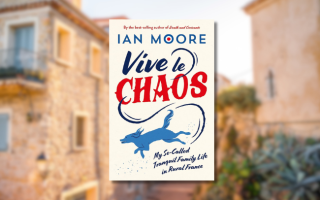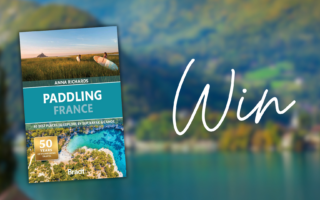Just horsing around
In the historic province of Le Perche, there’s no better way to see the countryside than from a cart pulled by the area’s iconic horse, the Percheron. DEBORAH NASH goes along for a ride
“I grew up with the Percheron horse,” C�line Maudet, equestrian and horse breeder, tells me at the family farm in Corbon, the Perche region of Basse- Normandie. “My parents had their first Percherons when I was small, so we grew up together. I learned to handle them, harness them, work with them, and love them.”
Right in front of me, are two Percheron mares, Kaoline and Ouraline, one a milky white, the other a dappled grey. They are being attached, through a complicated arrangement of straps, reins and halters, to the big wheeled cart that is to be my transport through the fields and forests of Montligeon and R�no-Valdieu.
“They’re calm animals,” she continues. “But if I ask them to liven up and go faster, then they know how to do that too.”
It is hard to imagine as we set off, swaying idly down a country road, that C�line competes with these very same draft horses in carriage competitions, galloping across difficult terrain. There is no such pressure today, and our carriage creaks out its singular rhythm that has neither the effortless speed of a Renault, nor the stop-start staccato of a walk.
But why, in this day and age, would anyone choose to travel by horse and cart?
“It’s the calm of the horses that’s so good,” is C�line’s emphatic reply. “The people I usually take are Parisians. They run around all day: M�tro, work, M�tro, home. We take our time here, we relax about all that. We might say we’ll start at 10am, but if we start at 10.30am, it doesn’t matter.”
It does indeed seem that we are ambling along in a different zone to the one I am used to; the only sound to break the silence is the peal of church bells recalling past summers when there were no clocks, only the chimes, bidding the men in the fields to rest or pray.
Call of the mild We clip-clop past wide fields of harvested corn tied up in giant buttery reels, past humpback hills edged by trees in full bloom, beneath skies unscarred by a single plane, down roads where the sighting of a car is as rare as finding a truffle. In this gentle wilderness I see the cream and brown spotty Normande cows with their distinctive lunettes about their eyes, the horses in meadows who touchingly race over to meet us when we approach, and two roe deer who dart into the safety of the trees.
Historically, the Perche was flush as well as lush. In the 17th and 18th centuries the area was largely selfsufficient, with the cultivation of cereals and the well-stocked forests meeting local needs. Wood, lace and horse-breeding brought in the wealth. The signs of this are all around; in the biscuit and ochre-coloured stone manors with terracotta tiled roofs that look as if they have grown straight from the ground and baked in the sun. Many of these houses are now owned by Parisians who use them as weekend retreats. The homeowners’ foxhounds, bumptious little guard dogs, greet our arrival in what are otherwise ghost villages. People are conspicuously absent.
Trotting up the steep cobbled streets of the little village of Montligeon, C�line tells me that this desertification is nothing new. In 1896, a priest here noticed that most of his flock was disappearing to the hungry city and so hit on a plan to build a basilica in Montligeon to hold on to the workforce. They were paid from monies earned by the church-owned printing press. It probably only temporarily stemmed the flow, but the basilica, the printing press and a worn sundial, a shadow of its former self, still remain, long after the stone masons and builders have gone.
We rattle by and, in a couple of measured horse hoof steps, we leave town and open country behind and are submerged in the deep, dappily green of soaring trees and brackeny scents of Montligeon wood.
Kaoline and Ouraline frisk their tails, a leaf floats down, a butterfly flutters past and we find ourselves on a narrow path that marks the boundary between what was once two parcels of privately owned woodland.
Train of thought As the horses plunge further in, we come to a disused overgrown railway line, long since abandoned, usurped by the car (and now, perhaps, the horse) and see the tiny oblong of a train carriage that has been converted into a miniature cottage – a secret place among the trees.
“When visitors come here they want to see the historic monuments that are in their guidebooks,” C�line says as she points it out to me. “But I want to show them what they didn’t come to see; the remote, hidden corners that they might never find. On my trips, we get to look at what is behind and beyond those classical fa�ades.”
Entering the state-owned R�no-Valdieu forest, the paths gradually broaden and straighten into avenues and, as if to echo the floor plan, the chestnuts and oaks do not spread out into the full shapes of their species but grow high (up to 40 metres), like pine trees. It is as if we are now part of a larger pattern, that the Percherons are taking us along ancient timelines stretching back hundreds of years. Tranquillity hangs in the air: the cathedral vastness of the forest, the husk of a monastery, the gentleness of our horses, the delicate bubbles of the cider we sip at our picnic lunch. But the spectre of war is not far away; this is Normandy after all. You might be thinking of the D-Day landings or the Falaise-Chambois gap, but I am listening to accounts of wars in the 14th and 15th centuries in which the Percheron horse played a part.
The docile Percheron was once a war horse, bred to carry men in armour and to pull cannons. The forest we are crossing had been planted under the orders of Louis XIV’s minister, Jean-Baptiste Colbert, who used the wood for battleships and turned France, briefly, into a naval power that rivalled Britain, leading to the second Hundred Years’ War 1689-1815. And who transported the wood to make the ships? Why, the Percheron, of course. Looping back to Corbon, we journey on the level, going downhill then pitching uphill, covering as many topics of conversation as we do miles: we talk about the trees, the soil, the animals (fox, roe deer, and what too many wild boar can do to a field of maize), plants and people.
Then we round a bend, a Labrador barks, and we are home. As I climb down from my steaming, warm-blooded steed, I ask C�line about her future plans.
“I’d like to do a trip that lasts two days,” she says, enthusiastically. “We could camp or stay in a chambres d’h�te, and stop at farms to sample their meat, butter, cheese, yoghurt, to visit these people who work so hard to offer us natural produce. I’d link it all up: the land, the horses, the farms, the food…”
That magic matrix of land, horse, farm and food will linger in my memory for some time to come
GETTING THERE By rail: from London to Argentan or L’Aigle. Visit www.raileurope.co.uk or call 0844 848 4064. Visit Rail Europe Travel Centre, 1 Regent Street, London SW1.
PLACES TO STAY Le Pavillon de Gouffern 61310 Silly-en-Gouffern Tel: (Fr) 2 33 36 64 26 www.pavillondegouffern.com
PLACES TO EAT Auberge de la T�te au Loup Chef St�phane Mabille 61310 Le Pin au Haras Tel: (Fr) 2 33 35 57 69
WHAT TO DO C�line Maudet L’Absoudi�re 61400 Corbon Tel: (Fr) 2 33 83 91 40 C�line offers nature treks on horseback, among other activities.
Le Haras National du Pin 61310 Le-Pin-au-Haras Tel: (Fr): 2 33 36 68 68 www.haras-national-du-pin.com The stud farm was built following a decree by Louis XIV’s prime minister Colbert, who introduced a breeding programme to provide horses for war.
Eco Mus�e Prieur� de Sainte-Gauburge61130 Saint-Cyr-la-Rosi�re Tel: (Fr) 2 33 73 48 06 www.ecomuseeduperche.fr Festival on 15 August every year.
Pascal and Josiane Lebegue Ferme de Montaumer, 61560 La Mesni�re Tel: (Fr) 2 33 25 09 30 http://cheval-percheron.ifrance.com Percheron breeders Pascal and Josiane give tours round their farm.
M. Bernard Gros La Ducherie, 61160 Chambois Tel: (Fr) 2 33 39 39 97 A collection of antique horse harnesses.
TOURIST OFFICE www.normandy-travel.co.uk
Share to: Facebook Twitter LinkedIn Email


